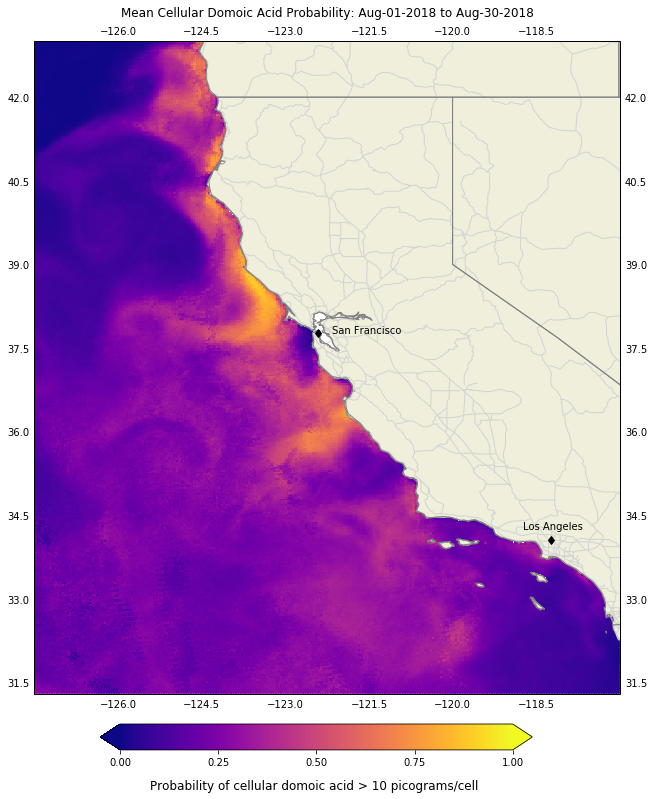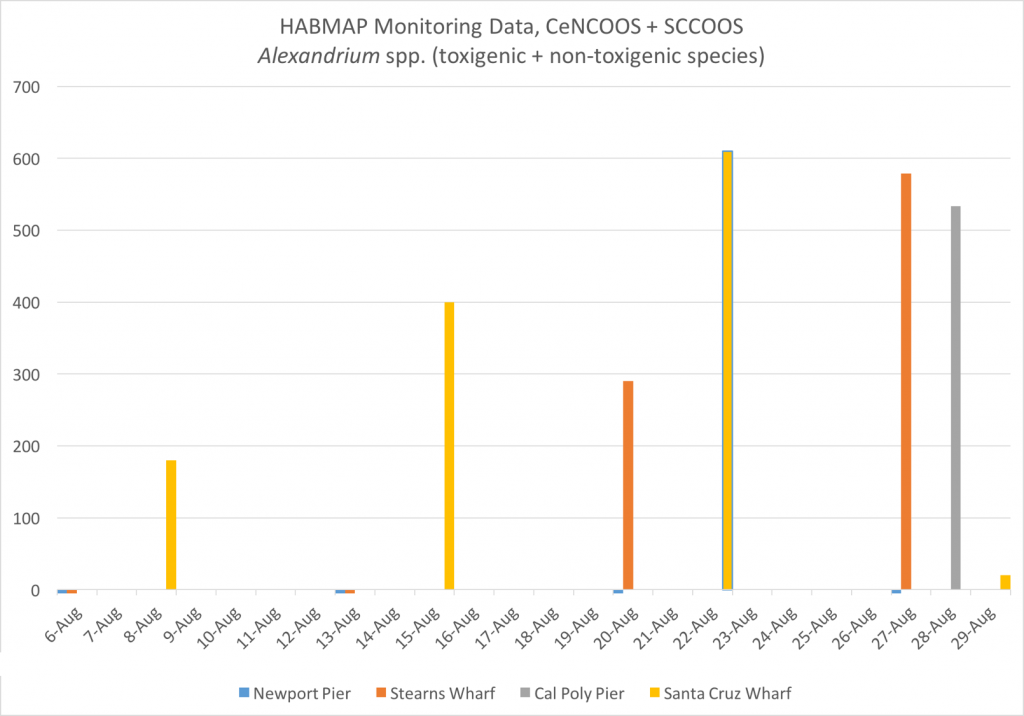Pseudo-nitzschia - C-HARM tells us where conditions are suitable for Pseudo-nitzschia spp. (all size classes) to grow well and where they might be more likely to produce domoic acid. In August, the probability of a Pseudo-nitzschia spp. bloom was still high all along the coast with some low offshore probabilities in the Southern California Bight near Orange and San Diego Counties. High nearshore probabilities of a Pseudo-nitzschia spp. bloom in Orange County were consistent with Harmful Algal Bloom Monitoring and Alert Program (HABMAP) weekly sampling at Newport Pier and Stearns Wharf in Santa Barbara, with "bloom" levels around Aug 20. There was not much action at Cal Poly Pier and Santa Cruz Wharf throughout August. If we isolate just the very large Pseudo-nitzschia that represent a rough approximation of the species most likely to be toxigenic, we see that this group dominated at Newport Pier in mid-August, albeit still at levels below the 10,000 cell/L bloom threshold. Note that there are not yet updated cell counts from Scripps Pier, Santa Monica Pier, and Monterey Wharf in the HABMAP archive for the month of August. CDPH monitoring of Pseudo-nitzschia showed percent composition was highest at the mouths of the San Francisco Bay and the Eel River in Humboldt County as well as fairly elevated in northern Monterey Bay and near Bodega Bay.
Domoic Acid - C-HARM predicted the highest likelihood of particulate domoic acid (pDA) production in the Southern CA Bight, the offshore region of central CA, and in the nearshore zone of the North Coast. Cellular domoic acid (cDA) predictions, which should tell us where Pseudo-nitzschia cells are likely to be most toxic on a per-cell basis, indicate that the Southern CA Bight is not currently a hot spot. The North Coast near Humboldt and Sonoma Counties and the central CA coast near Monterey Bay are regions predicted to have the highest cellular DA concentrations in August, much like in July. This is consistent with the early September shellfish advisory in Humboldt County. Unfortunately, DA values from the HABMAP sampling are not yet available at any of the pier locations. It may be that the high salinity that has accompanied the record warm temperatures in the Southern California Bight the last two years since the "Blob" is what is driving the high pDA predictions in the region. This is because there is a strong positive relationship between salinity and particulate domoic acid in the C-HARM pDA model. That relationship is not as strong for cDA. In August, central and north coast sea lion strandings from DA toxicosis were down from the peak in June but highly concentrated in Monterey Bay, and one stranding occurred in Sonoma County, which is consistent with very elevated cDA likelihoods (from C-HARM) in those areas. Several animals stranded along the San Luis Obispo County coastline, which is NOT consistent with low Pseudo-nitzschia abundance in the HABMAP data at Cal Poly Pier but is consistent with generally elevated pDA probabilities offshore of the central coastline.
Alexandrium - Unlike Pseudo-nitzschia, Alexandrium spp. were well-represented at the more northern sites of the Harmful Algal Bloom Monitoring and Alert Program (HABMAP) data, with abundances building at Santa Cruz Wharf over the course of the month (consistent with CDPH sampling shown below), culminating in fairly high cell counts at Santa Cruz Wharf, Cal Poly Pier, and even Stearns Wharf by the end of August.
C-HARM Model
Mean Probability of Pseudo-nitzschia Bloom for Aug 2018

Mean Probability of Particulate Domoic Acid for Aug 2018

Mean Probability of Cellular Domoic Acid for Aug 2018

HABMAP Observations
Note that "toxigenic" and "non-toxigenic" does not imply identification to the species level, only a rough size-class approximation.




CDPH observations for Pseudo-nitzschia spp. and Alexandrium spp.
From 1-31 August 2018, water samples were collected by volunteers and sent to the California Department of Public Health (CDPH) for analysis. Pseudo-nitzschia spp. were detected in 57 (47%) of the 123 samples. Percent composition of Pseudo-nitzschia spp. was greatest at the Pyramid Point on August 27th, Pacifica Pier on August 12th and Trinidad Pier on August 26th (62%, 60% and 44% respectively). Alexandrium spp. were detected at low levels (<3%) in 17 of the 61 sites sampled. You can also view CDPH weekly map layers of Pseudo-nitzschia and Alexandrium here. There are no advisories for ASP or PSP at this time.
Note the annual mussel quarantine is still in effect. The mussel quarantine is an annual event that happens due to dangerous levels of biotoxins that may be present in mussels gathered by the public anywhere on the California coast, including bays, inlets, and harbors. For the latest closures and updates, please visit the California Department of Fish and Wildlife (CDFW) Health Advisories page.
Data are provided by the California Department of Public Health, Environmental Management Branch.
August 1st - 31st 2018
Pseudo-nitzschia spp. Percent Composition

August 1st - 31st 2018
Alexandrium spp. Percent Composition

Central California Sea Lion Strandings from DA Toxicosis
The Marine Mammal Center in Sausalito, CA acts like an emergency room by working to rescue and rehabilitate sick and injured marine mammals, primarily California Sea Lions (Zalophus californianus). There have been a total of 76 sea lion strandings presenting with symptoms domoic acid toxicosis since January 2018, with 11 sea lion strandings in the month of August. Of the 11 sea lion strandings, one was released, the rest either died during treatment or were euthanized. Most of the August strandings came from the San Luis Obispo and Monterey Bay regions, despite the more toxigenic Pseudo-nitzschia species being more abundant in Southern California.
No DA toxicosis cases have been reported by the Pacific Marine Mammal Center in 2018.
August sea lion strandings occurred at the following locations:
- Oceano Dunes, Oceano
- Fishermans Beach, Avila Beach
- Morro Rock, Morro Bay
- Sunset State Beach, Watsonville
- Pleasure Point Park, Live Oak
- Santa Cruz Wharf, Santa Cruze
- Stinson Beach, Stinson Beach
- Ward Ave, Fort Bragg

